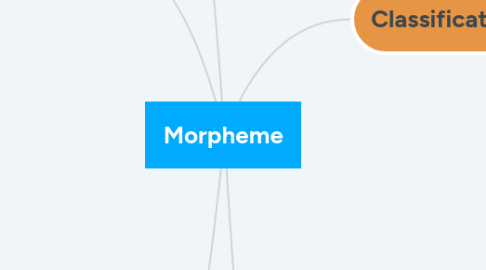
1. Definition
1.1. Short segment of language
1.1.1. A word/part of a word that has meaning
1.1.2. Recurs in differing verbal environments with a relatively stable meaning
1.1.3. Cannot be divided into smaller meaningful parts without violation of its meaning
2. Suffixal Homophones
2.1. {-er}
2.1.1. Inflectional - comparative of adjective
2.1.1.1. Ex: prettier
2.1.2. Derivational - attached to verb to form nouns
2.1.2.1. Ex: worker, teacher
2.1.3. Derivational - repetition
2.1.3.1. Ex: chatter, mutter, glitter
2.2. {-ing}
2.2.1. Inflectional - present participle
2.2.1.1. Ex: working
2.2.2. Derivational - form noun
2.2.2.1. Ex: meeting, wedding, readings
2.2.3. Derivational - Adjectival morpheme
2.2.3.1. Ex: charming, burning
2.2.4. Derivational - Gerund morpheme
2.2.4.1. Ex: Swimming is good for health.
2.3. {-ed}
2.3.1. Inflectional - past participle
2.3.1.1. Ex: The film has started.
2.3.2. Derivational - adjectival
2.3.2.1. Ex: She was excited about the film./ She was a devoted mother.
2.4. {-ly}
2.4.1. Derivational - adverbial
2.4.1.1. Ex: badly, freely, lately
2.4.2. Derivational - adjectival
2.4.2.1. Ex: lovely, friendly, lively
2.5. Homophones
2.5.1. Sound alike
2.5.2. Written differently
2.5.3. Different meaning
3. Allomorphs
3.1. Definition
3.1.1. Any of the different forms of a morpheme
3.1.2. Have different phonemic forms, but they have the same meaning
3.2. Kinds of allomorphs
3.2.1. Phonologically conditioned allomorphs
3.2.1.1. When the distribution was determined by the preceding sounds
3.2.1.2. When the related forms of a set have the same meaning and are in complementary distribution
3.2.1.3. Ex: {-d pt} = /-id/ /-t/ /-d/
3.2.2. Morphologically conditioned allomorphs
3.2.2.1. Determined by the morphological environment.
3.2.2.2. Classifications
3.2.2.2.1. The zero allomorphs
3.2.2.2.2. Additive allomorphs
3.2.2.2.3. Replacetive allomorphs
3.2.2.2.4. Suppletive allomorphs
4. Classifications
4.1. Form
4.1.1. Free morpheme
4.1.1.1. Can be uttered alone with meaning
4.1.1.2. Are monomorphemic words and they can operate freely in the language
4.1.2. Bound morpheme
4.1.2.1. Cannot be uttered alone with meaning
4.1.2.2. Must combine with other morphemes
4.2. Meaning
4.2.1. Roots (Bases)
4.2.1.1. Has principal meaning.
4.2.2. Affixes
4.2.2.1. Occurs before or within or after a base
4.2.2.2. Differ from roots in 3 ways
4.2.2.2.1. Do not from words by themselves
4.2.2.2.2. Their meaning os not as clear and specific as the meaning of roots, and many are meaningless
4.2.2.2.3. The number of affixes is relatively small
4.2.2.3. Classifications
4.2.2.3.1. By position
4.2.2.3.2. By function
5. Immediate Contituents
5.1. Definition
5.1.1. Any of the two meaningful parts forming a larger meaningful unit
5.2. Three recommendations
5.2.1. If a word ends in an inflectional suffix, the first cut is between this suffix and the rest of the word
5.2.2. One of the IC should be a free form
5.2.3. Meaning of the IC is related to the meaning of the world
